The World of Alice I Have Been
Other links of interest:
Oxford
The daughter of Henry George Liddell, the Dean of Christ Church, Oxford, Alice Pleasance Liddell grew up in the City of Dreaming Spires. Renowned for its academic, as well as architectural, history, Oxford is also known to modern readers as the inspiration for Hogwarts in the Harry Potter books.
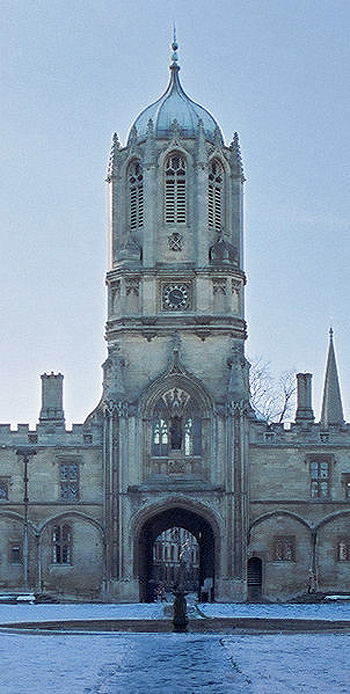 Tom Tower, Christ Church, Oxford
Tom Tower, Christ Church, Oxford
Charles Lutwidge Dodgson was a mathematics professor at Christ Church when he first met Alice and her family. At that time, all the dons had to be members of the clergy, single, and supposedly celibate. Enrollment was, naturally, restricted only to males. Prince Leopold, the youngest son of Queen Victoria, was one of many members of Royalty to matriculate at Christ Church, Oxford under Alice’s father’s leadership.
Even as he achieved international fame as Lewis Carroll, Charles Dodgson remained teaching at Oxford, never very popular among the students or faculty. Yet the university remains proud of its association with Carroll and Alice; stained glass windows in the Great Hall depict characters from Wonderland, and there are many Alice-themed shops and tours available to today’s visitors.
The Alice Books
On the “golden afternoon” of July 4, 1862, Charles Dodgson and his friend Robinson Duckworth rowed the three Liddell girls—Ina, Alice and Edith—down the Isis (or the Thames, as it’s known as it nears London) for a picnic lunch. During the trip, Dodgson began to tell the sisters the story of a little girl who followed a rabbit down a rabbit hole.
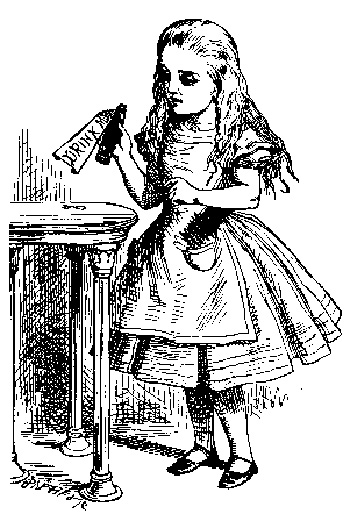 John Tenniel’s Alice illustration
John Tenniel’s Alice illustration
Afterward, Alice Liddell begged him to write the story down. It took him two years, but finally in November, 1864, he presented Alice with a handwritten, leather-bound book titled Alice’s Adventures Under Ground. He illustrated the book himself, and pasted a photograph of Alice at the age of seven in the back. By this time, however, he was estranged from the Liddell family, particularly Alice.
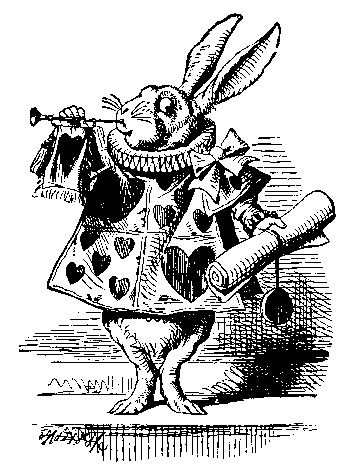 John Tenniel’s rabbit illustration
John Tenniel’s rabbit illustration
Friends of Dodgson’s read the book as he was preparing it, and urged him to have it professionally published. He decided to do so, even before he sent Alice her version; eventually he expanded the original 18,000 words to 35,000, and hired John Tenniel to do the illustrations. The Alice that Tenniel depicted, with the familiar long yellow hair, does not resemble Alice Liddell, who had short brown hair.
Re-titled Alice’s Adventures in Wonderland, written by Lewis Carroll, upon its publication in 1865 the book was an immediate success with adults and children alike; supposedly it was one of Queen Victoria’s favorite books. Dodgson—as Carroll—went on to publish Through the Looking Glass and What Alice Found There in 1871. Despite his continued estrangement from Alice and her family, he kept her up-to-date with the success of “her adventures,” as he always referred to them.
Neither book has ever been out of print, and both have been translated the world over. They continue to inspire today; in March, 2010, a Tim Burton-directed movie of Alice in Wonderland will be released by Disney.
Lewis Carroll, Photographer
In the 20th century, Lewis Carroll was suddenly rediscovered for another talent: Photography.
 Alice Liddell as a beggar girl,
Alice Liddell as a beggar girl,
taken by Charles Lutwidge Dodgson, circa 1859
Charles Dodgson was an early enthusiast of the art of photography. At the time, photographs were taken using the Wet Collodion Process. It was a tedious process, especially for the subject, who had to hold perfectly still for up to 45 seconds. This explains the rather stiff poses we usually associate with photographs of the era.
In 2002, an exhibit called “Dreaming in Pictures: The Photography of Lewis Carroll” toured museums around the country; it was this exhibit that inspired the writing of Alice I Have Been. There have been many articles and books written trying to explain or understand Dodgson’s apparent fixation on photographing prepubescent girls; the author Vladimir Nabokov, in a 1966 interview in Vogue magazine, even called him “Lewis Carroll Carroll,” a reference to his own character of Humbert Humbert in Lolita. Whatever the truth behind them, the images, taken as a whole, are startling to modern eyes. Still, what is most striking is how skilled Dodgson was as a photographer, how beautiful the portraits remain.
Alice was Dodgson’s early favorite subject; he met the Liddell family in 1856—Alice was barely 4—when he asked permission to photograph the Deanery garden, and soon after was entertaining and photographing the Liddell sisters regularly.
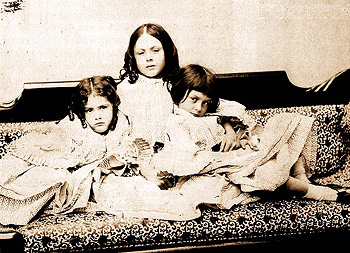 Edith, Ina and Alice Liddell,
Edith, Ina and Alice Liddell,
taken by Charles Lutwidge Dodgson, 1859
The Victorian Era
Alice Liddell was born in 1852, at the height of the Victorian Era; the grand and glorious age to which Queen Victoria gave her name. During this time, the sun never set on the British Empire, and save for the Crimean War near the beginning, and the Boer War near the end, it was a time of unprecedented peace, innovation and expansion.
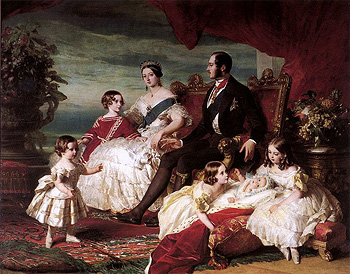 Queen Victoria, Prince Albert and children,
Queen Victoria, Prince Albert and children,
by Franz Xaver Winterhalter
Charles Dickens and Anthony Trollope fictionalized it; essayists such as John Ruskin and Thomas Carlyle chronicled it. Alice Liddell was certainly a product of it; born to the upper class, she was accustomed to a houseful of servants, the finest of carriages, a leisurely life of picnics, balls and Grand Tours of Europe.
Few women of the time could think of having a career of their own. For an upper class Victorian maiden, the only successful outcome in life was a proper marriage, and Alice’s mother certainly intended that her daughters not only marry properly, but brilliantly. The eldest daughter, Ina, married a member of the Scottish aristocracy; Alice’s closest sister, Edith, was engaged to marry a wealthy landowner’s son. The two youngest daughters, however—Rhoda and Violet—never married; family lore was that they had no interest in being stuck in the nursery as their mother had been, confined with pregnancy after pregnancy, as were most women of the time.
Despite rumors of many suitors among the undergraduates of Oxford—including Royal ones—Alice did not marry until she was twenty-eight; an alarming age for a Victorian maiden. When she did marry, it was to a genial country gentleman, Reginald Gervis Hargreaves. Alice then spent the rest of her life as a grand country lady running a grand country house, a Victorian through and through; she could be very class conscious, and was known to be rather stern with servants.
Upon her husband’s death in 1926—and as the aristocracy in England began to decline after the Great War—Alice was in danger of losing her house, Cuffnells; this was what prompted her to sell her original version of Alice’s Adventures Under Ground.
The Great War
The Victorian Era officially ended with the eruption of World War I, or as it was known at the time, The Great War.
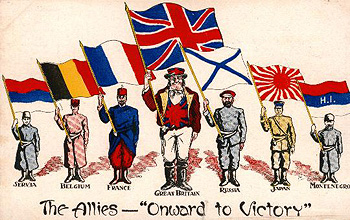 Propaganda Postcard circa 1916
Propaganda Postcard circa 1916
On June 28, 1914, Archduke Franz Ferdinand of Austria was assassinated by a Serbian nationalist. Soon all the great powers of Europe were at war; cousins were fighting against cousins, as most of the heads of state were related in some way to Queen Victoria, who had died in 1901. Kaiser Wilhelm II of German was her grandson, as was King George V of England.
The terrible trench warfare—chemical weapons were introduced during the Great War, with the horrifying Mustard Gas—changed forever the way wars are fought. Soldiers fought side-by-side, regardless of class, while at home in Great Britain, rationing was eventually instituted, Land Armies formed, and women left the serving class to work in munitions factories, just as they would, in greater numbers, during World War II. There were even air raids; beginning in 1915, over 550 British civilians were killed by bombs dropped from Zeppelins.
All three of Alice and Reginald Hargreaves’s sons—Alan Knyveton, Leopold Reginald, and Caryl Liddell—fought on the battlefields of France. In a sad irony, the son of Prince Leopold inherited the title of the Sovereign Duke of Saxe-Coburg and Gotha, which was part of the German Empire during the war, and eventually joined the Nazi party.
An excellent site to find out more:
FirstWorldWar.com
The Auction, and Alice in America
In 1928, Alice Liddell Hargreaves attended the Sotheby’s auction of many of her personally inscribed editions of the Alice books, including the original, handwritten Alice’s Adventures Under Ground sent to her in 1864. After the heated auction—which included bids from the British Museum—the manuscript sold to an American, Dr. A.S.W. Rosenbach, for the astonishing (at the time) sum of $77,000 US dollars. Dr. Rosenbach immediately offered to sell it back to the British Museum for the same amount, but the offer could not be met; he took the manuscript back to America, and then sold it to Eldridge Johnson.
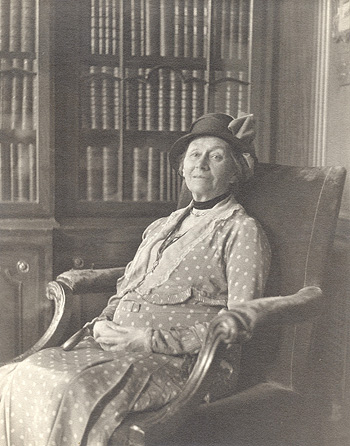 W. Coulbourn Brown
W. Coulbourn Brown
Alice Pleasance Liddell Hargreaves, 1932
Rosenbach Museum & Library, Philadelphia
In 1932, during the centennial celebrations of Lewis Carroll’s birth, Alice Liddell Hargreaves was invited to cross the ocean and receive an honorary degree from Columbia University in New York. There she was reunited with her original manuscript, which Mr. Johnson had arranged to have on display. It was also on this trip that she met another literary namesake: Peter Llewelyn-Davies, supposedly the inspiration for J.M. Barrie’s Peter Pan.
After the ceremonies, Alice returned to England, where she died in 1934. So, later, did the original manuscript return; in 1946, through a goodwill arrangement with the Library of Congress, the British Museum finally claimed it. It still resides there.

